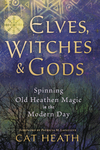Foreword to Elves, Witches & Gods
Foreword
When I heard that Catherine was writing a book, I was delighted. I respect her and all of the work she has done for the heathen community both locally and worldwide, even though her name itself is not yet highly known. "A book!" I thought. "I can't wait to see what she writes!"
Having read Elves, Witches & Gods, I have to say that the wait has been worthwhile. Personally, I use scholarship to inform my spiritual practice. One of the first things I look for in a book is: is there scholarship and if so, is that scholarship accurate? This book certainly is. Catherine has researched magic, seidhr, charms, and Anglo Saxon as well as Old Norse practices, and her process is ongoing. The book is full of historically, culturally, and archeologically relevant information. Where she has had to divert from Old Norse and Anglos Saxon sources to fill in a "blank spot," she has done so using other Indo-European sources, which she has clearly researched as thoroughly as the others. While full of research, Anglo-Saxon and Old Norse terms (among others), Catherine takes the time to define and explain in a way that makes the terms resonate with the reader rather than leaving them dry.
This is the second thing I look for in a book: is it readable? While I am just as fond of researching dry tomes full of doctorate level prose, I think that in general, books should be accessible to many people. This book is just that. Catherine writes in a clear, open prose that feels nearly conversational in its tone. She explains her topics, research, and thoughts using a narrative that does not patronize—rather, the prose is straightforward and easy to understand.
Perhaps the best thing I can say about this book is that it is useful. Catherine uses a mix of scholarship and personal experience and tracks how she arrived at a belief, ritual, or other practice. This means that the book spans the gap between old and modern. When possible, she uses the source materials directly—for example, using Anglo-Saxon era charms to ward off illness. When she uses her own understanding and inspiration to develop a practice, she clearly states that she is doing so, which means that the reader receives a thorough understanding of the place scholarship has in the modern record. Above all, this book is practical. Catherine has taken the time to show the reader where beliefs, practices, spirituality, and her processes come from, and encourages readers to develop their own practices in each chapter.
Catherine is very clear that this book is not for beginners. This is for people who already have basic beliefs and magical practices under their belt. That said, Catherine does provide what she calls "foundations"—discussing such things as meditation, visualization, and other ways to develop a long-term practice and build on already existing practices. Chapter by chapter, each ritual builds on those that came before it, which shows how intertwined witchcraft, magic, and seidhr are. Working with the dead, with elves, and with gods can be very dangerous. This is not work for the faint of heart.
Elves, Witches & Gods is, in my opinion, an essential book for any practitioner's shelf. It contains a wealth of information, practical foundational skill development, and advanced workings that help the reader both understand and practice on their own.
—Patricia Lafayllve, Author of A Practical Heathen's Guide to Asatru
About Cat Heath
Related Products

is subject to certain Terms and Conditions
